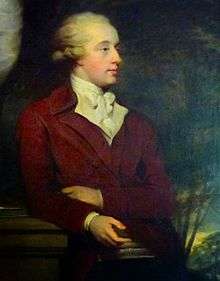Sir Richard Hoare, 2nd Baronet

Sir Richard Colt Hoare, 2nd Baronet FRS (9 December 1758, in Barnes, Surrey – 19 May 1838, in Stourhead, Wiltshire)[1] was an English antiquarian, archaeologist, artist, and traveller of the 18th and 19th centuries, the first major figure in the detailed study of the history of his home county of Wiltshire.
Career
Hoare was descended from Sir Richard Hoare, Lord Mayor of London, the founder of the family banking business, C. Hoare & Co. His parents were Sir Richard Hoare, 1st Bt. (b. 7 March 1734/35, d. 11 October 1787) and Anne Hoare (1737-1759). He was educated at Preparatory school at Wandsworth, Seminary school at Greenford, and taught the Classics by the Rev.d Joseph Eyre.
In 1785 he inherited the large Stourhead estate from his grandfather, Henry Hoare II,[2] which enabled him to pursue his interests including the archaeological studies for which he had already shown an inclination. In 1783 he had married Hester, daughter of William Lyttelton, 1st Baron Lyttelton.[3] After her death in 1785, following the birth of their second child, who also died, he toured France, Italy and Switzerland.[4] In 1786 he purchased Glastonbury Tor and funded the restoration of the church tower on it.[5]
He succeeded to the baronetcy in 1787, and in 1788 made a second continental tour,[6] the record of his travels appearing in 1815 and 1819 under the titles Recollections Abroad and A Classical Tour through Italy and Sicily.[7] He took numerous views during his travels in the form of sketches from which he later produced mainly sepia wash drawings, along with a smaller number of watercolours. His tutor, John 'Warwick' Smith, and the painter Francis Nicholson were also commissioned to produce coloured reductions from some of his continental sketches. Bound in volumes, many of these were dispersed in the Stourhead sales of the 1880s.

A journey through Wales was followed by a translation of the Itinerarium Cambriae and of the Descriptio Cambriae of Gerald of Wales, with Hoare adding notes and a life of Gerald to his translation. This work was first published in 1804, and was subsequently revised by Thomas Wright (1810–1877) in 1863. Hoare's further Tour in Ireland was published in 1807.[8]
Hoare was elected a Fellow of the Royal Society in 1792 and was also a Fellow of the Society of Antiquaries of London. He was appointed High Sheriff of Wiltshire for 1805.
He died at Stourhead, Wiltshire, in 1838. His mausoleum is at St Peter's Church, Stourton, Wiltshire.
Contributions to archaeology
The first recorded excavations at Stonehenge were done by William Cunnington & Richard Colt Hoare in 1798 and again in 1810. They dug around a fallen Trilithon and a fallen slaughter stone and they discovered that it had once stood up. Colt Hoare excavated 379 barrows on Salisbury Plain as well as identifying many other sites in the area, publishing and classifying his findings. However as the three-age system had not yet been introduced he was unable to date his finds and therefore at a disadvantage when trying to interpret them. His two-volume book The Ancient History of Wiltshire outlined his findings.[9] [10]
Hoare's most important work was his Ancient History of North and South Wiltshire (1812–1819); he also sponsored and contributed significantly to the 11 volumes of the History of Modern Wiltshire (1822–1844).
Publications
- The Historical Works of Giraldus Cambrensis, includes Hoare's translation
- Journal of a tour in Ireland, A.D. 1806 (1807)
- A Catalogue of Books Relating to the History and Topography of Italy (1812)
- A Tour Through the Island of Elba (1814)
- Hints to travellers in Italy (1815)
- Recollections abroad, during the years 1790 (1817)
- A Classical Tour Through Italy and Sicily (1819) – vol1 – vol2
- A Letter, Stating the True Site of the Ancient Colony of Camulodunum (1827)
References
- ↑ Sir Richard Colt Hoare, 2nd Baronet (1758-1838)
- ↑ Hutchings, V. p 84
- ↑ Sir Richard Colt Hoare, 2nd Bt. at thepeerage.com
- ↑ Sir Richard Colt Hoare, Recollections Abroad, During the Years 1785, 1786, 1787 (Bath: Richard Cruttwell, 1815), text online
- ↑ R. W. Dunning (editor), M.C. Siraut, A.T. Thacker, Elizabeth Williamson (2006). "Glastonbury: Parish". A History of the County of Somerset: Volume 9: Glastonbury and Street. Institute of Historical Research. Retrieved 26 October 2013.
- ↑ Hutchings, V. p 85
- ↑ Sir Richard Colt Hoare, Recollectionds Abroad, During the Years 1790: Sicily and Malta (Bath: Richard Cruttwell, 1817), text online
- ↑ Sir Richard Colt Hoare, Journal of a Tour in Ireland, A.D. 1806 (London: William Miller, 1807), text online
- ↑ Colt Hoare, Richard (1812). The Ancient History of Wiltshire, Vol. 1. London: William Miller.
- ↑ Colt Hoare, Richard (1821). The Ancient History of Wiltshire, Vol. 2. London: Hughes, Harding, Maver and Lepard.
 This article incorporates text from a publication now in the public domain: Chisholm, Hugh, ed. (1911). Encyclopædia Britannica (11th ed.). Cambridge University Press.
This article incorporates text from a publication now in the public domain: Chisholm, Hugh, ed. (1911). Encyclopædia Britannica (11th ed.). Cambridge University Press.- Victoria Hutchings, Messrs Hoare, Bankers: A History of the Hoare Banking Dynasty (2005)
| Baronetage of Great Britain | ||
|---|---|---|
| Preceded by Richard Hoare |
Baronet (of Barn Elms) 1787–1838 |
Succeeded by Henry Hugh Hoare |
|